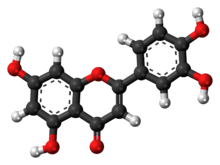Luteolin
 | |
 | |
| Names | |
|---|---|
| IUPAC name
2-(3,4-Dihydroxyphenyl)- 5,7-dihydroxy-4-chromenone | |
| Other names
Luteolol Digitoflavone Flacitran Luteoline | |
| Identifiers | |
| 491-70-3 | |
| 3D model (Jmol) | Interactive image |
| ChEBI | CHEBI:15864 |
| ChEMBL | ChEMBL151 |
| ChemSpider | 4444102 |
| ECHA InfoCard | 100.007.038 |
| 5215 | |
| PubChem | 5280445 |
| UNII | KUX1ZNC9J2 |
| |
| |
| Properties | |
| C15H10O6 | |
| Molar mass | 286.24 g·mol−1 |
| Except where otherwise noted, data are given for materials in their standard state (at 25 °C [77 °F], 100 kPa). | |
| | |
| Infobox references | |
Luteolin is a flavone, a type of flavonoid. Like all flavonoids, it has a yellow crystalline appearance.[1]
Natural occurrences
Luteolin is most often found in leaves, but it is also seen in rinds, barks, clover blossom, and ragweed pollen.[1] It has also been isolated from the aromatic flowering plant, Salvia tomentosa in the mint family, Lamiaceae.[2]
Dietary sources include celery, broccoli, green pepper, parsley, thyme, dandelion, perilla, chamomile tea, carrots, olive oil, peppermint, rosemary, navel oranges, and oregano.[3][4] It can also be found in the seeds of the palm Aiphanes aculeata.[5]
References
- 1 2 Mann, John (1992). Secondary Metabolism (2nd ed.). Oxford, UK: Oxford University Press. pp. 279–280. ISBN 0-19-855529-6.
- ↑ A. Ulubelen; M. Miski; P. Neuman; T. J. Mabry (1979). "Flavonoids of Salvia tomentosa (Labiatae)". Journal of Natural Products. 42 (4): 261–3. doi:10.1021/np50003a002.
- ↑ Kayoko Shimoi; Hisae Okada; Michiyo Furugori; Toshinao Goda; Sachiko Takase; Masayuki Suzuki; Yukihiko Hara; Hiroyo Yamamoto; Naohide Kinae (1998). "Intestinal absorption of luteolin and luteolin 7-O-[beta]-glucoside in rats and humans". FEBS Letters. 438 (3): 220–4. doi:10.1016/S0014-5793(98)01304-0. PMID 9827549.
- ↑ López-Lázaro M. (2009). "Distribution and biological activities of the flavonoid luteolin". Mini Rev Med Chem. 9 (1): 31–59. doi:10.2174/138955709787001712. PMID 19149659.
- ↑ Lee, D; Cuendet, M; Vigo, JS; Graham, JG; Cabieses, F; Fong, HH; Pezzuto, JM; Kinghorn, AD (2001). "A novel cyclooxygenase-inhibitory stilbenolignan from the seeds of Aiphanes aculeata". Organic Letters. 3 (14): 2169–71. doi:10.1021/ol015985j. PMID 11440571.
This article is issued from Wikipedia - version of the 10/5/2016. The text is available under the Creative Commons Attribution/Share Alike but additional terms may apply for the media files.